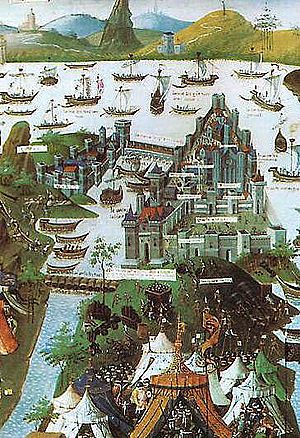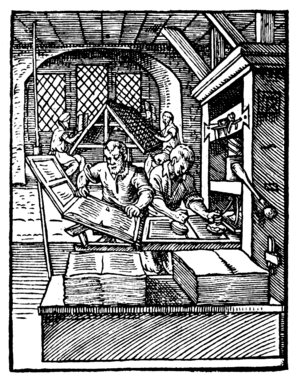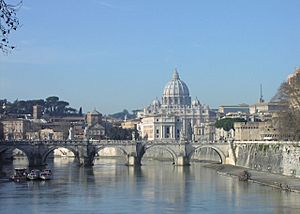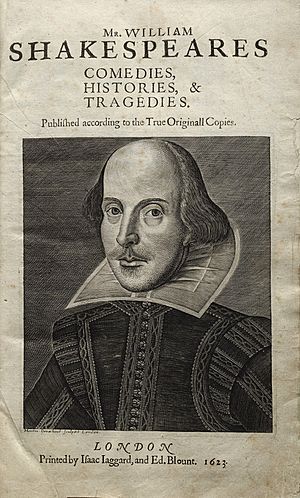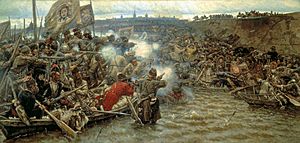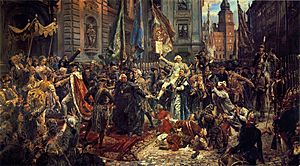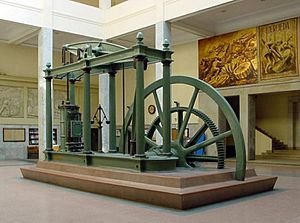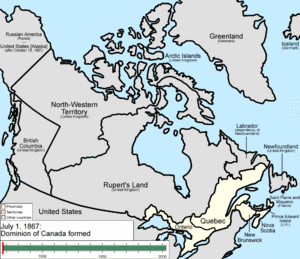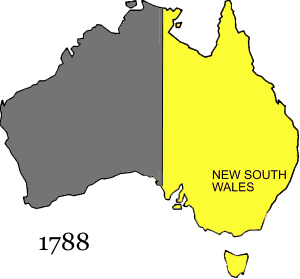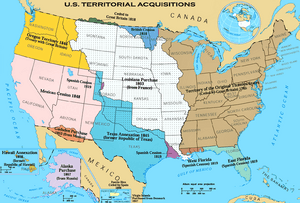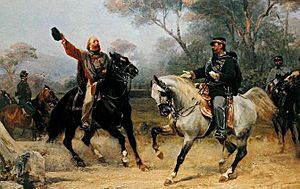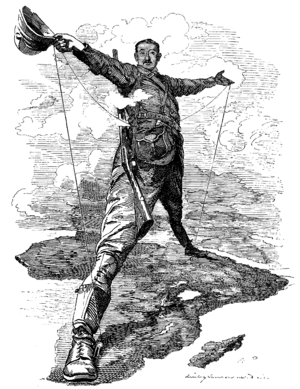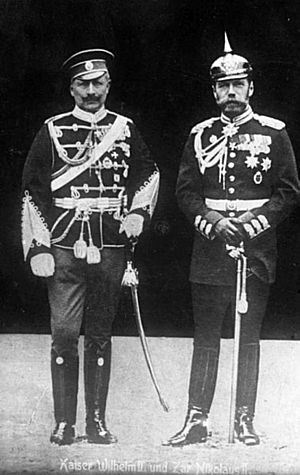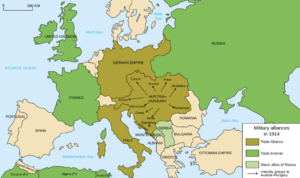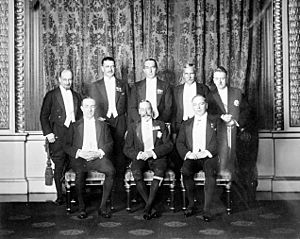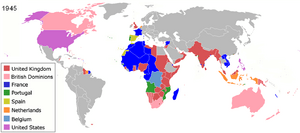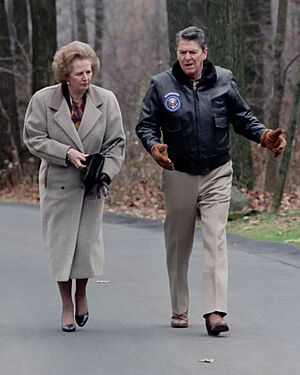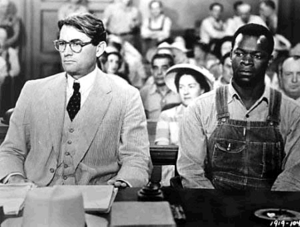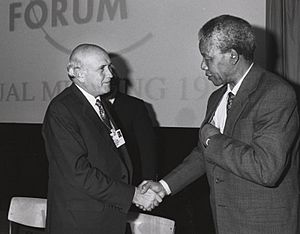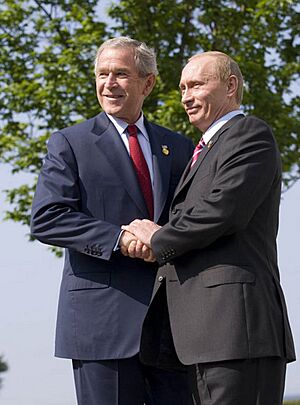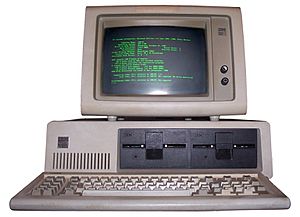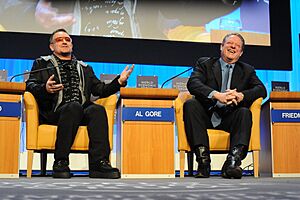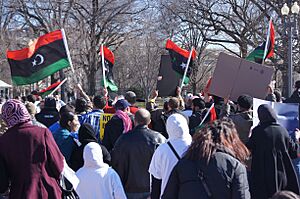History of Western civilization facts for kids

Western civilization has its beginnings in Europe and the Mediterranean region. Its history is connected to ancient Greece, the Roman Empire, and the Medieval period. During these times, big changes happened, like the growth of Scholasticism (a way of thinking and learning), the Renaissance (a time of rebirth in art and science), the Reformation (changes in religion), the Enlightenment (new ideas about government and people), the Industrial Revolution (new machines and factories), and the Scientific Revolution (new discoveries in science). Western civilization also saw the development of liberal democracy, where people vote for their leaders.
The civilizations of Classical Greece and Ancient Rome were very important in Western history. Groups like the Franks, Goths, and Burgundians also added a lot to Western culture after they became Christian. Charlemagne, a powerful king, is even called the "Father of Europe." Ideas from pre-Christian groups like the Celts and Germanic pagans, and religious ideas from Judaism, also influenced Western culture. For most of its history, Western Christianity has been a huge part of shaping Western civilization. Today, Western civilization has spread to places like the Americas and Oceania, and it has a big influence all over the world.
After the Fall of Rome in the 5th century, Europe entered the Middle Ages. The Catholic Church became very powerful in Western Europe. Meanwhile, the Eastern Roman Empire (also called the Byzantine Empire) continued in the East. By the 12th century, Western Europe saw a new growth in art and learning. This was helped by building huge cathedrals, starting medieval universities, and learning from the Islamic world through places like Al-Andalus (Spain) and Sicily. Many Arabic texts on science and philosophy were translated into Latin.
However, the Christian world split in the 16th century because of the Reformation. A new group of merchants grew in city states, especially in Italy. This led to the Renaissance from the 14th to the 17th century, a time of great progress in technology and art. It also started the Age of Discovery, when European empires like Portugal and Spain explored and claimed lands around the world.
The Industrial Revolution began in Britain in the 18th century. Influenced by the Enlightenment, the Age of Revolution started in the United States and France. This transformed the West into its modern, industrial, and democratic form. North and South America, South Africa, Australia, and New Zealand became new Western nations. Africa and Asia were mostly divided among Western powers. By the end of the 20th century, most of Europe had democratic leaders, even after periods of Fascism and Communism. Many Western nations were involved in the First and Second World Wars, and the long Cold War. After World War II, the United States and the Soviet Union became the two main global powers.
After World War II, European empires mostly ended. Civil rights movements and people moving from different backgrounds to Europe, the Americas, and Oceania changed Western culture. European nations started working together more through the European Union. The Cold War ended around 1990 when Soviet Communism collapsed in Central and Eastern Europe. In the 21st century, the Western World still has a lot of economic power and influence globally. The West has given the world many new things in technology, politics, philosophy, art, and religion. It was a place where Catholicism, Protestantism, democracy, and industrialization grew. It was also the first major civilization to try to end slavery in the 19th century and the first to let women vote. It invented technologies like steam, electric, and nuclear power. The West also created cinema, television, radio, the telephone, the automobile, rocketry, flight, electric light, the personal computer, and the Internet. Famous Western artists include Michelangelo, Shakespeare, Leonardo da Vinci, Beethoven, Vincent van Gogh, Picasso, Bach, and Mozart. Sports like soccer, cricket, golf, tennis, rugby, and basketball were developed in the West. And in 1969, humans from the West landed on the Moon for the first time.
Contents
- Ancient Times: Before AD 500
- The Middle Ages: 500–1500
- Renaissance and Reformation: 14th to 17th Century
- Rise of Western Empires: 1500–1800
- Enlightenment and Revolution: 1500–1815
- Rise of the English-Speaking World: 1815–1870
- Continental Europe: 1815–1870
- Culture, Arts, and Sciences: 1815–1914
- New Imperialism: 1870–1914
- Great Powers and the First World War: 1870–1918
- Between the Wars: 1918–1939
- Second World War and Its Aftermath: 1939–1950
- Fall of Western Empires: 1945–1999
- Cold War: 1945–1991
- Western Countries: 1945–1980
- Western Nations: 1980–Present
- See also
Ancient Times: Before AD 500
The Greco-Roman world laid the groundwork for Western civilization.
The Middle Ages: 500–1500
Early Middle Ages: 500–1000
After the Fall of Rome in AD 476, Western Europe faced a decline in education and organization. However, the Christian religion slowly regained its power. The papacy (the Pope's office) became a strong source of authority. Pope Gregory the Great (around 540–604) helped the Church become a major power in Italy.
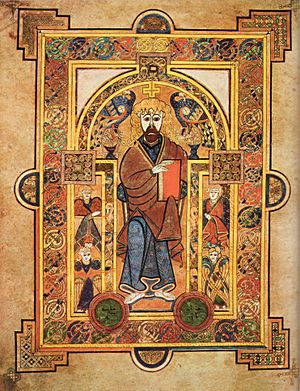
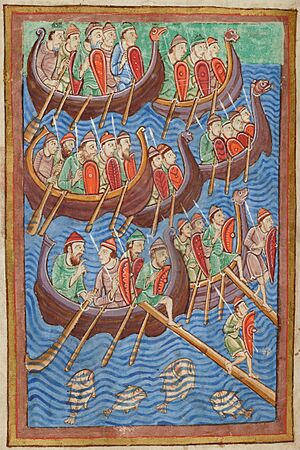
Christianity survived in Ireland, which the Romans never conquered. Monks in places like Ireland kept old Western writings alive. By around 800, they were creating beautiful books like the Book of Kells. Irish monks also helped spread Christianity back into Western Europe.
Around AD 500, Clovis I, King of the Franks, became Christian and united Gaul (modern France). In the 6th century, missionaries from Ireland helped convert England to Christianity.
In AD 570, Muhammed, the founder of Islam, was born. His new religion, Islam, quickly spread across the Middle East and North Africa. By the early 8th century, Muslims had conquered parts of Spain and Sicily. However, in 732, the Frankish leader Charles Martel stopped the Muslim advance into Europe. From this time, "the West" often meant lands ruled by Christians.
Charlemagne (Charles the Great) became King of the Franks. He conquered a large empire, and in 800, Pope Leo III crowned him Holy Roman Emperor. After his rule, his empire split into what would become France, the Holy Roman Empire, and a middle kingdom.
Starting in the late 8th century, Vikings attacked European towns. They eventually conquered parts of Ireland, England, and northern France (Normandy). However, their rule didn't last long. By the 11th century, Scandinavia was Christian and part of Western civilization. Viking explorers reached Iceland, Greenland, and even North America, but only Iceland was settled permanently.
Other groups like the Magyars also swept through Europe. They settled in what is now Hungary, became Christian, and formed the Hungarian people. The Poles also formed a unified Christian state by the 10th century.
By the year 1000, Western Europe had three main language groups: Romance languages (like French, Italian, Spanish), Germanic languages (like English, German, Dutch), and Celtic languages (like Irish, Scots Gaelic).
High Middle Ages: 1000–1300
Around the year 1000, Western Europe began a "great age of civilization." The Catholic Church was very powerful and connected people across Europe. Smart people often joined religious orders, which helped spread ideas.
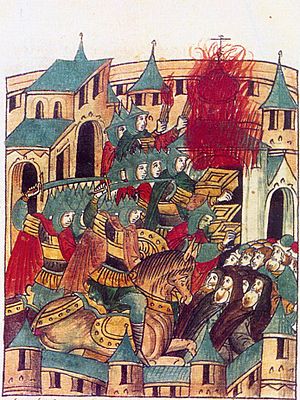
Huge abbeys and cathedrals were built, decorated with amazing art. Abbot Suger of the Abbey of St. Denis was a key supporter of Gothic architecture. He believed that beauty could bring people closer to God.
By the year 1000, feudalism was the main social system. Kings gave land to nobles, who gave land to vassals (knights), and peasants worked the land. This system declined as the threat of invasions lessened.

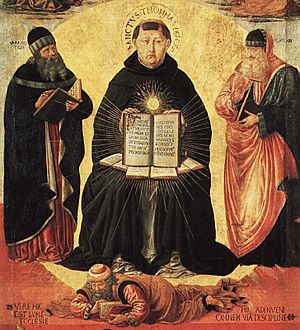
In 1054, the Great Schism split the Christian world into the Catholic Church (West) and the Orthodox Church (East). The last pagan lands in Europe, the Baltic peoples, became Christian, joining Western civilization.
The idea of Chivalry and knighthood became important, focusing on courtesy and service. Many grand Gothic cathedrals were built, like Canterbury Cathedral and Chartres Cathedral. This period also saw the rise of St Francis of Assisi and the epic poetry of Dante Alighieri. New religious orders like the Dominicans and Franciscans focused on poverty and spirituality.
Women in the Church, like abbesses, could be very powerful. Devotion to the Virgin Mary also became central, teaching "tenderness and compassion."
In 1095, Pope Urban II called for a Crusade to take back the Holy Land from Muslim rule. The First Crusade was successful, but later ones were not. The Crusades had big impacts on Europe, but they also increased the divide between Eastern and Western Christianity.
After the fall of Rome, many Greek texts were translated into Arabic and kept safe in the Islamic world. These texts, along with Arabic science and philosophy, were later brought back to Western Europe and translated into Latin during the Renaissance of the 12th century.
Cathedral schools grew into medieval universities, like the University of Bologna. These universities encouraged free thinking and produced great scholars like Robert Grosseteste and Albert the Great.
Philosophy in this period focused on religion. Scholasticism emerged, emphasizing scientific observation. Important philosophers like Saint Anselm and Saint Thomas Aquinas tried to prove God's existence through reason.
The Normans, originally Vikings who settled in France, became important in medieval Europe. They were known for their fighting spirit and Christian faith. They built unique Romanesque architecture and established kingdoms in Sicily and England (after the Norman Conquest of England).
Kings and the Church sometimes clashed. For example, Henry IV had to beg Pope Gregory VII for forgiveness. As kings gained more power, nobles tried to keep theirs.
The Plantagenet kings ruled England from the 12th century. King John of England signed the Magna Carta in 1215, which limited the king's power and protected certain rights. This document was very important for the development of constitutional monarchy. Institutions like the Parliament of England and universities like Cambridge and Oxford also began in this period.
From the 12th century, new inventions appeared, like the canal lock and the deep-sea ship with a magnetic compass.
Late Middle Ages: 1300–1500
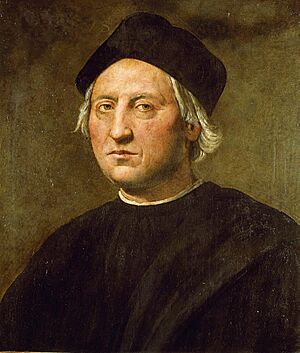
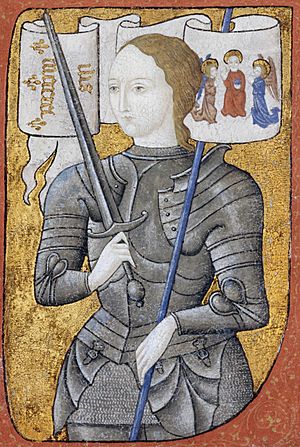
Colder temperatures led to food shortages. The Black Plague arrived in Europe in 1347, likely brought by the Mongols. This terrible disease killed about 20 million people, up to a third of Europe's population.
The Papacy moved to Avignon from 1305 to 1378, which weakened the Pope's power. Later, the Western Schism saw rival Popes, further hurting the Church's image before the Protestant Reformation.
The Hundred Years' War (1337–1453) was fought between England and France. France, inspired by Joan of Arc, eventually won, gaining back most of its land.
The Ottoman Turks continued to expand into Europe, capturing Constantinople in 1453. This event, where the Ottomans used cannons to break down the city's ancient walls, marked the end of the Eastern Roman Empire. Greek scholars fleeing to the West helped revive knowledge of Classical Antiquity.
By the 14th century, the middle class grew, leading to more towns and cities and a better economy. This helped start the Renaissance in Italy, a time of new ideas and art.
Renaissance and Reformation: 14th to 17th Century
The Renaissance: 14th to 17th Century
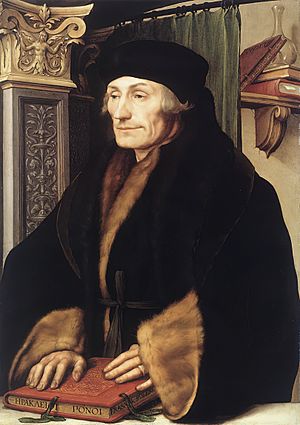
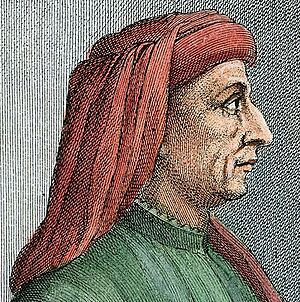
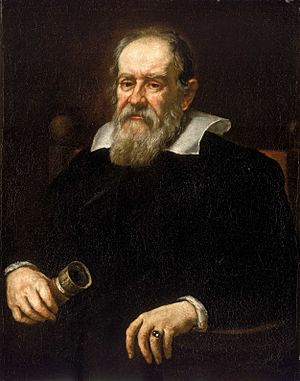
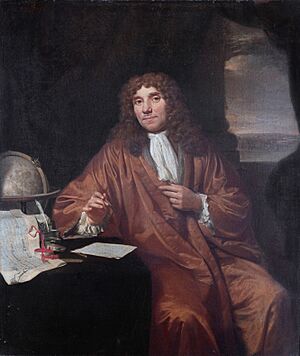
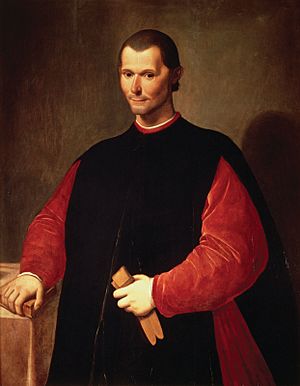
The Renaissance, starting in Italy, brought a new era of scientific and intellectual discovery. Wealthy merchant cities like Florence supported artists and scientists. Families like the Medici helped the Italian Renaissance flourish. Great artists like Brunelleschi, Botticelli, Leonardo da Vinci, Michelangelo, Titian, and Raphael created amazing works, making art more realistic.
Around 1450, Johannes Gutenberg invented the printing press, which allowed books and ideas to spread much faster. Thinkers like Machiavelli studied Roman history for lessons on government. Humanism became important, focusing on human nature and worldly topics rather than just religious ones. Writers like Petrarch and Boccaccio wrote in both Latin and their local languages.
By 1500, Europe was thriving. Leonardo da Vinci painted the Mona Lisa, Christopher Columbus reached the Americas (1492), Vasco Da Gama sailed around Africa to India, and Michelangelo painted the Sistine Chapel.
Important artists in Northern Europe included Bosch and Dürer. In Spain, Miguel de Cervantes wrote Don Quixote. The most famous playwright was William Shakespeare, whose plays like Hamlet and Romeo and Juliet are still loved today.
Meanwhile, Christian kingdoms in Spain and Portugal continued to fight to take back the peninsula from Muslim rule. In 1492, the last Muslim stronghold, Granada, fell. Spain and Portugal then explored and expanded overseas. Columbus found the Americas, and Vasco da Gama opened a sea route to India.
The 16th century also saw the Scientific Revolution. Nicolaus Copernicus discovered that planets revolve around the sun. The telescope and microscope were invented, leading to new discoveries about the universe and tiny living things. Galileo Galilei and Antonie van Leeuwenhoek were key figures. Isaac Newton pioneered the science of physics.
The Reformation: 1500–1650


The Reformation was another major movement in the 16th century that ended Europe's religious unity. It began in 1517 when Martin Luther, a Catholic monk, criticized the Church's wealth and some of its beliefs. His ideas led to the founding of the Lutheran Church. Other reformers followed, and their followers became known as Protestants.
John Calvin founded a church in Geneva that emphasized strict rules and God choosing who would be saved. His ideas spread to the Netherlands and Scotland. In England, King Henry VIII broke from the Pope and founded the Church of England. Many different Protestant groups formed. Protestants generally believed the Bible was the only source of divine truth.
The Catholic Church responded with the Counter Reformation. They made some changes, like stopping the sale of indulgences. New religious orders, like the Society of Jesus (Jesuits), were formed to spread Catholicism.

Religious wars broke out across Europe, especially in the Holy Roman Empire. The Thirty Years' War (1618–1648) was devastating, but it ended with the Peace of Westphalia, which granted religious tolerance to Lutherans, Catholics, and Calvinists.
By 1650, Scandinavia, northern Germany, parts of Switzerland, the Netherlands, and Britain were Protestant, while the rest of the West remained Catholic. The Reformation also led to more people learning to read, as Protestants wanted everyone to read the Bible.
Rise of Western Empires: 1500–1800
Age of Discovery and Colonization
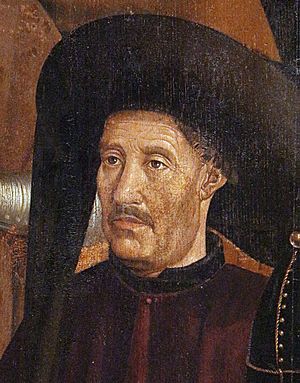


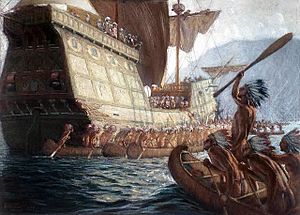
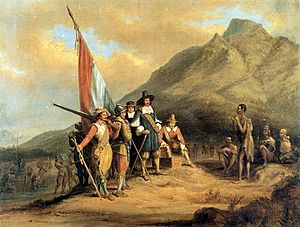
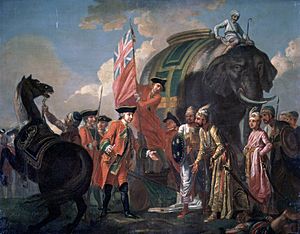
By 1500, Westerners used new technologies to explore unknown waters, starting the Age of Discovery. Explorers from Portugal, Spain, Holland, France, and England set out to find new shipping routes and "new worlds."
In 1492, Christopher Columbus sailed for Spain and landed in the Americas. This led to Spanish colonization and the spread of Western civilization there. Vasco da Gama sailed around Africa to India (1497–1499), opening new trade routes. Ferdinand Magellan led the first expedition to sail around the world (1519–1522).
European expansion deeply affected the Americas. Spanish Conquistadors conquered the Aztec Empire and the Inca Empire. Spain and Portugal claimed vast territories. Europeans had superior technology like gunpowder and also brought diseases that wiped out many native people. Native populations were converted to Catholicism and adopted European languages. Many European settlers married native people, creating a mixed population.
Other European powers, like the English, Dutch, and French, also established colonies in North and South America and the West Indies. The Columbian Exchange involved the transfer of goods between the Old and New Worlds. Europeans brought cattle and horses to the Americas, and received tobacco and potatoes.
Slavery became a major part of the colonial economy. Enslaved Africans were forcibly brought to the Americas to work on plantations. This "triangular trade" connected Europe, Africa, and the Americas. Slavery continued until the abolitionist movement in the 19th century.
Westerners also established colonies in Africa and Asia. Portugal controlled ports in Africa and Asia. The Dutch colonized Indonesia, and Spain conquered the Philippines. Most of India was divided between England and France.
European powers competed for land and resources, leading to conflicts like the Anglo-Dutch wars and the Seven Years' War. The Seven Years' War (1756–1763) involved fighting on several continents and led to Britain gaining much of France's territory in North America and India.
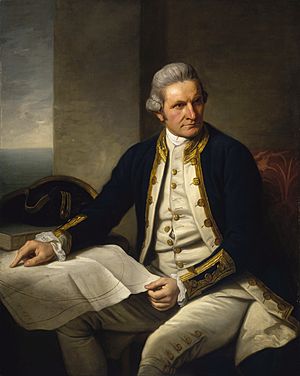
The Dutch navigator Willem Janszoon was the first Westerner to land in Australia in 1606. Abel Tasman later mapped Tasmania and New Zealand. The English navigator James Cook mapped the east coast of Australia in 1770. His voyages greatly expanded European knowledge of distant lands.
This period of expansion changed the world. New crops improved European diets, and the new colonies boosted the economy. This led to population growth in the West. Mercantilism, where colonies existed for the benefit of the mother country, became the economic model.
Enlightenment and Revolution: 1500–1815
Absolutism and the Enlightenment: 1500–1800
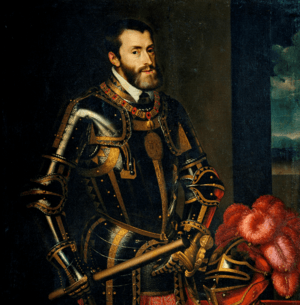


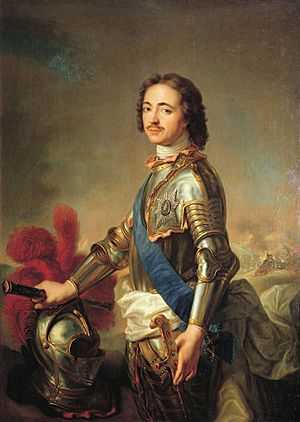
In the early modern era, the balance of power shifted. Nobles lost influence, and monarchs gained more power, believing in the Divine right of kings (that their power came directly from God). This led to absolutism.
Europe still faced threats from the Muslim Ottoman Empire. The Ottomans captured Constantinople in 1453 and expanded into Europe. However, a Christian coalition defeated the Ottoman navy in 1571, and a Polish-led coalition defeated them at the Battle of Vienna in 1683, pushing them back.
The 16th century was Spain's "Golden Century" (Siglo de Oro), thanks to gold and silver from its American colonies. Charles I and Philip II were powerful Spanish monarchs. However, overspending and conflicts led to Spain's decline by the 17th century.
The Dutch became a major world power in the 17th century, establishing a large colonial empire. By the 18th century, France and England emerged as the two greatest powers.
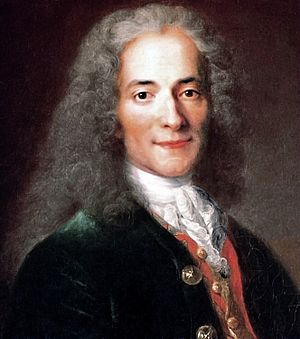

Louis XIV of France built the grand palace of Versailles. In Germany, Prussia became a powerful Protestant nation, often defeating Austria in wars. Austria, ruled by the Habsburg dynasty, also became a large empire.
England was different from other European nations because absolutism did not take hold there. Conflicts between the king and Parliament led to the English Civil War. King Charles I was executed in 1649. After a period without a king, the monarchy was restored. In 1688, the Glorious Revolution led to William III and Mary II becoming co-monarchs, but they had to sign the English Bill of Rights, which guaranteed rights to Englishmen and established Parliament's power. In 1707, England and Scotland united to form the Kingdom of Great Britain.
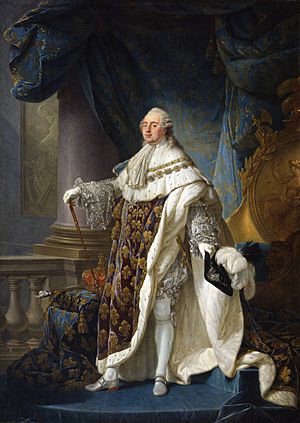
The Polish–Lithuanian Commonwealth was known for its unique political system and religious tolerance. Its Constitution of 3 May 1791 was one of the first of its kind in Europe.
The Age of Enlightenment was an intellectual movement that emphasized equality and that governments should get their power from the people. Enlightenment thinkers, called philosophes, admired Athenian democracy and the Roman Republic. They believed reason could create an ideal society.
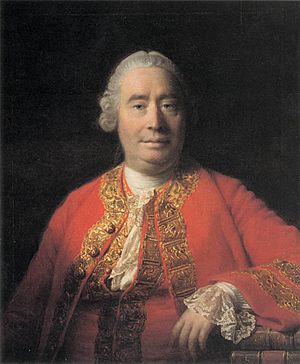
John Locke wrote that people have natural rights like life, liberty, and property, and that people could overthrow governments that didn't protect these rights. Voltaire criticized the monarchy and Church. Montesquieu suggested dividing government into executive, legislative, and judicial branches.
The Scottish Enlightenment saw many intellectual and scientific achievements. Adam Smith wrote The Wealth of Nations, the first work in modern economics, arguing for free markets.
European cities like Paris and London grew. France became the cultural center of the West. The middle class became more powerful.
Russia, under Czar Peter the Great, began to look westward and modernize, but it remained a unique civilization.
Revolution: 1770–1815
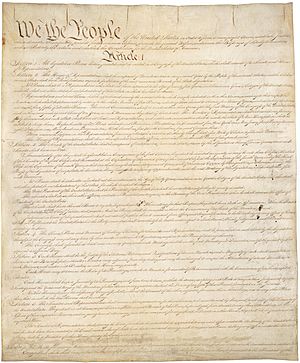

The late 18th and early 19th centuries saw a series of revolutions that changed history. The first began in North America. The Thirteen Colonies of British North America resented taxes imposed by Britain without their representation.
On July 4, 1776, the colonies declared independence with the United States Declaration of Independence. This document stated that "all men are created equal" and have rights to "Life, Liberty and the pursuit of Happiness." It also said that governments get their power from the people, and if a government becomes destructive, the people have the right to change or abolish it. George Washington led the new Continental Army to victory against the British, and the United States of America was formed.
The French Revolution began in 1789 due to economic crisis and Enlightenment ideas. The Third Estate (common people) formed the National Assembly, demanding more power. On July 14, 1789, a mob stormed the Bastille prison. Feudalism was abolished, and France moved towards a constitutional monarchy. However, other European powers went to war with France, and King Louis XVI was executed. France became a republic, but then faced the Reign of Terror under Robespierre. In 1799, Napoleon Bonaparte seized power, becoming a dictator and later emperor.
The motto "Liberté, égalité, fraternité" (Liberty, equality, fraternity) came from the French Revolution and represents the goals of modern Western government.
Some thinkers, like Edmund Burke, criticized the revolution's excesses, while others, like Thomas Paine, defended its ideals. Mary Wollstonecraft wrote A Vindication of the Rights of Woman (1792), arguing for equal education for women.
Napoleonic Wars

The Napoleonic Wars (1803–1815) were a series of conflicts involving Napoleon's French Empire. These wars changed European armies and spread revolutionary ideas across Europe. Napoleon conquered much of Europe, but his empire collapsed after a disastrous invasion of Russia in 1812. The wars led to the end of the Holy Roman Empire and helped create feelings of nationalism in Germany and Italy. The Spanish Empire also began to weaken, leading to independence movements in its American colonies. The British Empire became the main world power for the next century.
Napoleon's new army, based on mass conscription, was very effective. Even after Napoleon's defeat, the revolutionary ideas of a sovereign nation survived and led to more democratic changes in the 19th century.
The success of the American Revolution also inspired Spain's American colonies to seek independence. By the 1820s, most of Latin America had gained independence from Spain.
Rise of the English-Speaking World: 1815–1870
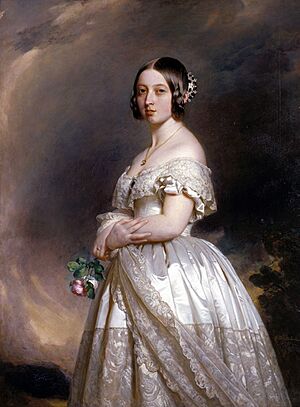
After the Napoleonic Wars, Britain and the United States expanded rapidly. This period helped establish English as a dominant language and Anglo-American culture as dominant in two continents.
Industrial Revolution in the English-Speaking World
The Industrial Revolution continued to grow, starting in Britain. Thomas Newcomen developed a steam engine in 1712. Steam power, fueled by coal, led to the first steam-powered railroad locomotive in 1804. Goods were produced in factories, leading to many people moving to cities. Factory work was often harsh, with long hours and dangerous conditions, even for children.
These problems led to reforms by the mid-19th century. The economic model shifted from Mercantilism to capitalism, where private investors ran companies. New ideas like socialism and communism emerged, criticizing industrial society. Trade unions were formed to fight for workers' rights. The social hierarchy changed, with capitalists becoming powerful.
Great Britain: 1815–1870

From 1837 to 1901, Queen Victoria reigned over Great Britain and the growing British Empire. This period, called the Pax Britannica (British Peace), saw Britain become the most powerful nation. The monarch became more of a symbol, with real power held by the prime minister and Parliament. Reforms granted more representation to industrial cities and removed laws against Catholics. More rights were given to workers and elementary education became state-supported.
Ireland, ruled by London, suffered a devastating famine in the mid-19th century, leading to mass emigration.
British Empire: 1815–1870
Britain's power grew enormously. The British Empire had outposts on every continent. By 1858, all of India was under British rule. Britain also expanded into Burma and fought the First Opium War (1840–1842) with China, forcing China to open to trade.
In 1833, Britain ended slavery throughout its empire. British settlement continued in southern Africa, leading to conflicts with the Dutch descendants called Boers. Explorers like David Livingstone became national heroes.
Canada: 1815–1870
After the American Revolution, many British loyalists moved north to Canada. British settlement increased, and new colonies like Ontario and New Brunswick were established. Rebellions led Britain to confederate the colonies into Canada in 1867, giving them a degree of self-rule. Canada was unique for having a French-speaking province, Quebec.
Australia and New Zealand: 1815–1870
The first British convicts arrived in New South Wales, Australia, in 1788, establishing a penal colony. The wool industry and good governors helped transform it into a civil society. Other colonies were established, and explorers ventured inland. A free colony was founded in South Australia in 1836, becoming a center for democratic reform. The Australian gold rushes brought prosperity and diversity.
The native Aborigines were largely displaced by European expansion and suffered from European diseases.
In New Zealand, European explorers and missionaries arrived. In 1840, Britain signed the Treaty of Waitangi with the native Māori. As more European settlers arrived, conflicts occurred, but by 1870, New Zealand had a mostly European population.
United States: 1815–1870

After independence, the United States expanded westward. In 1803, the U.S. bought the Louisiana Territory from France, doubling the country's size. Revolutions in Spain and Portugal's American empires led to the independence of nearly all of Latin America.
The U.S. bordered Mexico, and Americans settled in Mexico's northern territories like Texas and California. This led to cultural clashes and the Mexican–American War. The U.S. won, gaining vast territories in the West. In 1867, the U.S. bought Alaska from Russia.
Politically, the U.S. became more democratic, but voting was limited to white males. Slavery became the most important issue. Northern states outlawed it, while Southern states relied on it. In 1860, Abraham Lincoln, an anti-slavery candidate, was elected president. Southern states seceded, forming the Confederate States of America, leading to the American Civil War (1861–1865).
The Union (North) eventually won. Lincoln was assassinated, but his Republican Party outlawed slavery and granted black men voting rights. However, equal treatment for black people would remain a challenge. Lincoln's Gettysburg Address (1863) famously called for a "new birth of freedom" and "government of the people, by the people, for the people."
Continental Europe: 1815–1870
After the Napoleonic Wars, Europe saw many changes. Industrial technology spread from Britain to France, the Low Countries, and Germany. Cities grew, connected by railroads. New ideologies like socialism and communism (created by Karl Marx) emerged, criticizing industrial society. Marx believed history was a struggle between classes, and workers would eventually rise up and abolish private property.
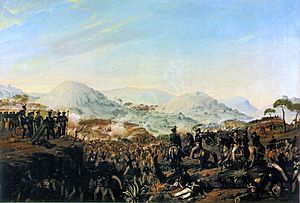
Many revolutions occurred in Europe, aiming for democracy. Some were successful for a time, but their effects were often reversed. Greece and Serbia gained independence from the Ottoman Empire. Belgium successfully revolted against Dutch rule in the 1830s, forming the Kingdom of Belgium.
In 1848, revolutions occurred in Prussia, Austria, and France. In France, King Louis-Philippe was overthrown, and a republic was declared. Louis Napoleon, Napoleon I's nephew, became emperor. Revolutionaries in Prussia and Italy pushed for unified German and Italian states.
Italian unification began in 1859. The Kingdom of Sardinia allied with France and defeated Austria. Many Italian states voted to join Sardinia, creating the Kingdom of Italy under Victor Emmanuel II. Garibaldi led revolutionaries to unite southern Italy with the new kingdom. Italy completed its unification in 1870 by conquering the Papal States.
Prussia, led by King Wilhelm I and Chancellor Otto von Bismarck, became the dominant power in Germany. Prussia defeated Denmark (1864) and Austria (1866), forming the North German Confederation.
After dealing with Hungarian revolutionaries, the Austrian emperor Franz Joseph divided his empire into Austria and Hungary, creating the Austro-Hungarian Empire in 1867.
By 1870, most Western European nations had some democracy, and two new nations, Italy and Germany, had been created. Europe's economy was transforming with industrialism.
Culture, Arts, and Sciences: 1815–1914


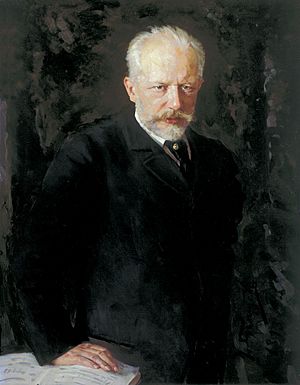
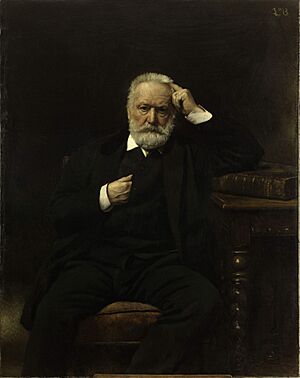


The 19th and early 20th centuries saw major changes in Western art, literature, and religion.
Napoleon re-established the Catholic Church in France. After the Napoleonic Wars, Catholicism revived. In Britain, laws against Catholics were largely removed in 1829. New churches like the Methodists were founded. Many Westerners became less religious, though most still held Christian beliefs.
In 1859, Charles Darwin published On the Origin of Species, proposing that organisms adapt to their environment and new species evolve. Gregor Johann Mendel studied inheritance in plants, starting modern genetics. Louis Pasteur and Joseph Lister made discoveries about bacteria. Geologists found evidence that the Earth was much older than previously thought. The telegraph was invented, allowing global communication.
In 1869, Dmitri Mendeleev published his Periodic table of elements. At the end of the 19th century, discoveries in physics, like Maria Skłodowska-Curie's work on radioactivity, paved the way for modern physics.
In art, Neoclassicism emerged, returning to the simpler art of the Renaissance. Romanticism then rejected Enlightenment ideas, emphasizing emotion and nature. Important Romantic musicians included Franz Schubert and Pyotr Tchaikovsky. Romantic art focused on color and motion to show emotion, often using Greek and Roman myths. Nature was also a key theme. Famous Romantic writers included William Wordsworth and Victor Hugo.
Women writers also gained prominence. Mary Wollstonecraft argued for equal education for women. Her daughter, Mary Shelley, wrote Frankenstein, exploring the potential dangers of science.
Realism emerged in the early 19th century, portraying the hardships of the poor in industrial society. It offered a starker vision compared to Romanticism. Famous Realist painters included Gustave Courbet and Jean-François Millet. Writers like Charles Dickens (Oliver Twist) and Victor Hugo (Les Misérables) captured the new industrial age. Russian novelists like Leo Tolstoy (War and Peace) and Fyodor Dostoevsky (Crime and Punishment) became internationally famous. American literature also developed with writers like Mark Twain (Adventures of Huckleberry Finn).
Architecture during the Industrial Age often revived past styles, like the Gothic Revival, seen in the re-built Palace of Westminster in London.
Impressionism grew out of Realism. Impressionists focused on capturing light and color. Famous Impressionists included Claude Monet and Pierre-Auguste Renoir. Post-Impressionism followed, with artists like Vincent van Gogh.
The Industrial Revolution brought more leisure time, leading to the growth of spectator sports. Many modern sports were developed or codified in Britain, including cricket, tennis, soccer, and rugby. The United States developed baseball and basketball. The modern Olympic Games were revived in Athens in 1896.
New Imperialism: 1870–1914
Between 1870 and 1914, Western power expanded greatly. By 1914, Western empires, along with Japan, Russia, and the Ottoman Empire, dominated the world. The main Western powers in this New Imperialism were the United Kingdom, France, Germany, Italy, and the United States.
Europeans explored the interior of Africa, leading to the "Scramble for Africa" where European nations competed for control. France occupied Algeria, and Britain annexed Egypt. Most of Africa was divided among European powers, with only Liberia and Ethiopia remaining independent. Europeans built railroads, schools, and factories. The Suez Canal was built in Egypt, allowing ships to travel between the Atlantic and Indian Oceans without going around Africa.
In Asia, China was forced to open to Western trade after the Opium Wars. European powers, Russia, and Japan established spheres of influence in China. Southeast Asia was divided between French Indochina and British Burma. India remained a key part of the British Empire.
The Pacific islands were conquered by Germany, the U.S., Britain, and France. In 1898, the U.S. annexed Hawaii.
Latin America was mostly free from foreign rule, but the U.S. and Britain had influence. The U.S. gained colonies like Puerto Rico and the Philippines after the Spanish–American War in 1898.
Competition over colonies sometimes led to wars between Western powers, and between Western powers and non-Westerners. The Russo-Turkish War (1877–78) further weakened the Ottoman Empire.
Great Powers and the First World War: 1870–1918
By the late 19th century, Great Britain, the United States, and Germany were the main global powers. France, Russia, Austria-Hungary, and Italy were also significant.
Western inventors transformed the West. Thomas Edison pioneered electricity and motion pictures. The Wright brothers made the first successful airplane flight in 1903. Automobiles were invented. Petroleum became important for powering machines. Steel was developed, allowing for skyscrapers. Guglielmo Marconi invented radio communication, and Alexander Graham Bell invented the telephone.
The Second Industrial Revolution created great wealth for entrepreneurs like Andrew Carnegie and John D. Rockefeller. Unions continued to fight for workers' rights, leading to laws limiting working hours and outlawing child labor.
Culturally, this period was known as the Victorian era in English-speaking nations and the Belle Époque in France. The suffragette movement began, seeking voting rights for women. New Zealand and Australia granted women's suffrage in the 1890s.
Cities grew rapidly, leading to challenges like overcrowding and pollution, but also improvements in public services. Paris, with its gas and electric lights and the Eiffel Tower, was seen as a model modern city.
United States: 1870–1914

After the American Civil War, the U.S. saw great changes. Southern states rejoined the Union, but then passed segregation laws and laws preventing black people from voting.
Americans settled the western territories, leading to new states. Conflicts with Amerindians resulted in their forced relocation to reservations.
America's population grew rapidly due to immigration, especially from Europe. Immigrants often faced discrimination but found work and freedom. They contributed to American culture and changed its religious landscape.
The U.S. became a major military and industrial power, surpassing Britain and Germany by 1900. However, most Americans preferred to stay out of world affairs.
Europe: 1870–1914
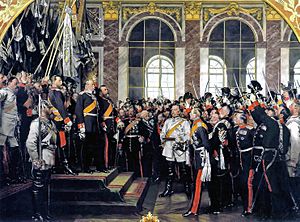
Germany rose as the dominant power in Europe, becoming the world's greatest industrial power and having the mightiest army. After winning the Franco-Prussian War (1870–1871), Prussia gained territory from France, and Wilhelm was proclaimed the first German Emperor, uniting all German states except Austria.
France became a republic after the Franco-Prussian War. It faced internal divisions and industrial weakening. Britain maintained its vast empire and saw peaceful changes in government.
British Dominions: 1870–1914
Canada, Australia, New Zealand, and South Africa continued to grow and develop democratic parliaments. Canada became a dominion of the British Empire in 1867. New Zealand gained home rule in 1852 and became a dominion in 1907. Australia's colonies federated into the Commonwealth of Australia in 1901. The Union of South Africa was formed in 1910.
These dominions became "laboratories of democracy." By the 1870s, they had granted voting rights to citizens earlier than most other Western nations. New Zealand was the first self-governing nation to grant women's suffrage in 1893. Australia also introduced the secret ballot and minimum wage.
Rival Alliances
The late 19th century saw two rival alliances in Europe: the Triple Alliance (Germany, Italy, Austria-Hungary) and strong ties between France and Russia. Russia supported Slavic nations in the Balkans, leading to tensions with Austria-Hungary and the Ottoman Empire. Britain allied with France, forming the Entente Cordiale. These alliances, along with competition for colonies and military buildups, increased the chance of a major European war.
World War I
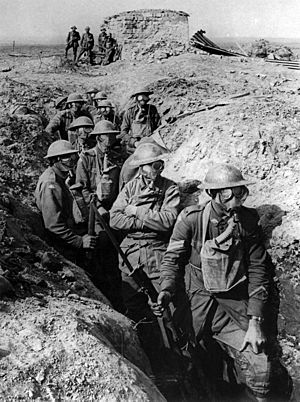
World War I began on June 28, 1914, when Franz Ferdinand, heir to the Austro-Hungarian throne, was assassinated. Austria-Hungary declared war on Serbia, leading Russia to declare war on Austria-Hungary. Germany declared war on Russia and France. Britain declared war on Germany after it invaded neutral Belgium.
The war quickly became a stalemate, with trenches dug from the North Sea to Switzerland. New weapons like machine guns, airplanes, tanks, and submarines were used. Even chemical weapons were deployed. The war spread globally, with colonial armies fighting in Africa and the Pacific.
In 1917, the United States entered the war after Germany tried to ally with Mexico against the U.S. The same year, Russia withdrew from the war after a revolution led by Vladimir Lenin and the Communists.

American troops and weapons helped turn the tide against Germany, which surrendered in 1918. The treaties ending the war, like the Versailles Treaty, were harsh on Germany and its allies. The Austro-Hungarian Empire was abolished, and Germany was greatly reduced in size. Many nations regained independence, including Poland and Czechoslovakia. Germany was forced to accept responsibility for the war and pay reparations.
The war cost millions of lives and left many dissatisfied with the peace agreements. The League of Nations, an international organization meant to prevent future wars, proved ineffective.
Between the Wars: 1918–1939
United States in the Interwar Years
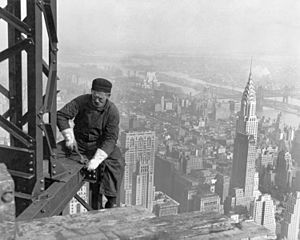
After World War I, Americans wanted a "return to normalcy." The 1920s were a time of economic prosperity in the U.S. Many bought cars, radios, and invested in the stock market. Women gained the right to vote.
In October 1929, the stock market crashed, leading to the Great Depression. Millions lost jobs and savings. In 1932, Franklin D. Roosevelt was elected president. His "New Deal" policies regulated banks, created public works programs, and provided pensions for the elderly, helping to ease the Depression's effects.
Europe in the Interwar Years
Europe was unstable after World War I. Germany faced a deep financial crisis, and Europe also suffered from the Great Depression. This led to the spread of radical ideologies like Communism and Fascism.
The Polish–Soviet War (1919–1921) saw Poland defeat Russia, preventing the spread of communism into Europe for two decades.
In Ireland, the Irish War of Independence (1919–1921) led to the island being divided. Northern Ireland remained part of the United Kingdom, while the rest became the Irish Free State. In 1918, the UK granted women the right to vote.
British Dominions in the Interwar Years
The relationship between Britain and its Empire changed. The Balfour Declaration of 1926 stated that Britain and its dominions (like Canada, Australia, New Zealand) were equal and independent, united by loyalty to the Crown. This was formalized by the Statute of Westminster 1931.
Rise of Totalitarianism
The inter-war years saw the rise of totalitarian regimes. The first was in Russia, renamed the Union of Soviet Socialist Republics (Soviet Union). The government controlled every part of its citizens' lives, persecuting religion and demanding loyalty to the Communist Party. Joseph Stalin made this state even more brutal.
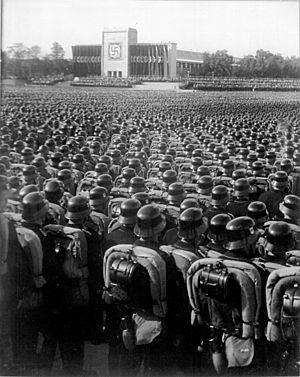
The first totalitarian state in the West was Fascist Italy. Fascism rejected democracy and emphasized intense nationalism, led by a powerful dictator. Benito Mussolini founded the Fascist Party after World War I. In 1922, Mussolini seized power, building up Italy's military and ending democracy. He also signed the Lateran Treaty with the Pope, creating Vatican City.
Another Fascist party, the Nazis, took power in Germany. The Nazis, led by Adolf Hitler, believed Germans were a "master race" and hated Jews. In 1933, Hitler became Chancellor and seized dictatorial power. He built up Germany's military and stripped Jews of their rights, leading to World War II.
In Spain, a republic was proclaimed in 1931. A military coup in 1936 started the Spanish Civil War, which ended in 1939 with Francisco Franco becoming dictator.
Second World War and Its Aftermath: 1939–1950
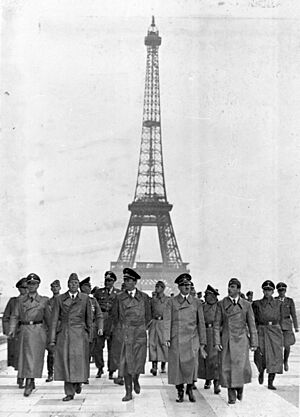
In the late 1930s, Germany violated the Versailles Treaty by annexing Austria and parts of Czechoslovakia. Britain and France tried to avoid war by agreeing to some of Hitler's demands, but he broke his promises. Hitler also formed a secret pact with the Soviet Union.
Italy conquered Ethiopia, and Japan invaded China. Japan's government was controlled by militarists who wanted an empire in Asia.
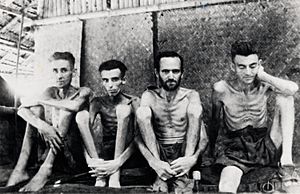

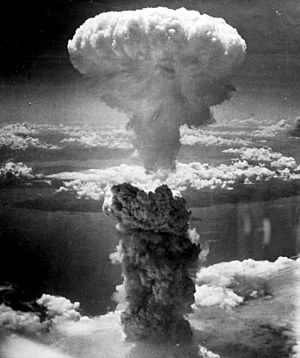
In 1939, German forces invaded Poland, starting World War II. France and Britain declared war on Germany. The war used new technologies like bombers, improved submarines, and radar. German forces quickly conquered France. In 1940, Germany, Italy, and Japan formed the Axis Powers. Hitler tried to defeat Britain with air power in the Battle of Britain, but the British, led by Winston Churchill, resisted.
In June 1941, Germany invaded the Soviet Union. The United States tried to stay neutral but began sending aid to Britain, China, and the Soviets. In 1941, Japan attacked Pearl Harbor, an American naval base, leading the U.S. to declare war on Japan. Germany and Italy then declared war on the U.S. The United States, the British Commonwealth, and the Soviet Union became the Allies.
In the Pacific War, Allied troops fought Japan. The Battle of Midway (1942) effectively defeated the Japanese navy.
By 1942, German and Italian armies controlled much of Europe and North Africa. Japan controlled much of Asia and the Pacific. Life in these empires was brutal. The the Holocaust saw 11 million people, including 6 million Jews, systematically murdered by the German Nazis.
From 1943, the Allies gained the upper hand. American and British troops liberated North Africa and Italy. They then invaded France on D-Day (1944), pushing towards Germany. The Soviets pushed Germans out of the Soviet Union and Eastern Europe. In 1945, the Allies invaded Germany, and Hitler committed suicide. Germany surrendered.
The war against Japan continued. The U.S. used a new weapon, the atomic bomb, on Hiroshima and Nagasaki, leading Japan to surrender.
After the war, the U.S., Britain, and the Soviet Union tried to cooperate. The United Nations was created to prevent future wars. However, cooperation ended when the Soviet Union set up Communist dictatorships in Central and Eastern Europe. Germany was divided into a democratic west and a Communist east. The former Axis nations, Italy and Japan, regained independence.
World War II cost millions of lives and devastated economies. But it also ended Fascism as a major ideology. The U.S. and Soviet Union emerged as the world's two superpowers.
Fall of Western Empires: 1945–1999
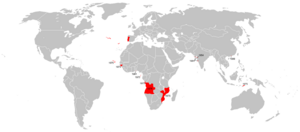
After World War II, European colonial empires began to collapse. This was due to war-damaged economies, opposition to imperialism from the U.S. and Soviet Union, changing Western attitudes, and the rise of independence movements.
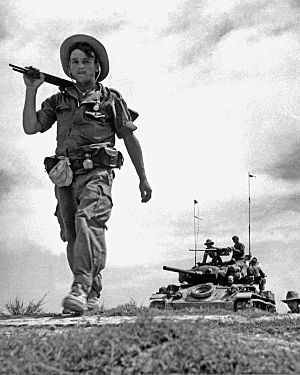
The first colonies to gain independence were in Asia. The U.S. granted independence to the Philippines in 1946. Britain granted independence to India, dividing it into India and Pakistan in 1947. Burma gained independence in 1948, and Indonesia in 1949. French Indochina gained independence after a conflict, becoming Laos, Cambodia, North Vietnam, and South Vietnam.
In the Middle East, Britain granted independence to Iraq, Kuwait, and Jordan. France granted independence to Syria and Lebanon. British Palestine became a challenge, leading to the creation of Israel in 1948.
Africa was also freed from colonial rule. Egypt, Ghana, and Tunisia gained independence. Algeria fought a violent war for independence from France, gaining it in 1962. By the 1970s, most of Africa was independent.
By the end of the 20th century, European colonial empires had largely ended. Britain remained linked to its former empire through the Commonwealth of Nations. Canada, Australia, and New Zealand became prosperous migrant nations. The French and Dutch empires also shrank. Spain's legacy remained in Latin America, where Catholicism became a global religion.
Only the Russian Empire, transformed into the Soviet Union, remained a major geopolitical force, but it too collapsed in the early 1990s. The end of Western empires changed the world, leading to new nations, but also sometimes to conflict and authoritarian rule.
Cold War: 1945–1991

From the end of World War II until the early 21st century, world politics were dominated by tensions between the United States and the Soviet Union. The Soviets established Communist satellite states in Central and Eastern Europe. The Berlin Wall was built to prevent East Berliners from escaping to West Berlin, becoming a symbol of the Cold War.
The U.S. took an active role to stop Communist expansion. The Marshall Plan financed the rebuilding of Western Europe, making it prosperous again. In 1949, the North Atlantic Treaty Organization (NATO) was formed, an alliance where members agreed to defend each other if attacked. The Soviets responded with the Warsaw Pact, an alliance of Communist countries.

One of the first Cold War conflicts was the Chinese Civil War, where Communists won in 1949, establishing the People's Republic of China. Japan became a democratic ally of the U.S. In 1950, the Korean War broke out when North Korea invaded South Korea. UN forces, mostly American, intervened, leading to a stalemate and a divided Korea.
The world lived in fear of World War III and nuclear war. Both the U.S. and Soviet Union developed atomic bombs and missiles capable of destroying the world. The Cuban Missile Crisis in 1962, where the Soviets placed nuclear missiles in Cuba, brought the world to the brink of war but was resolved peacefully.
The Vietnam War (1960s–1970s) was another major Cold War conflict. The U.S. supported South Vietnam against Communist North Vietnam, but after many years, the U.S. withdrew, and South Vietnam fell.
By the 1970s, global politics became more complex, with divisions even within the Communist world between the Soviets and Chinese.
The last major armed conflict of the Cold War was the Soviet invasion of Afghanistan in 1979. The U.S. supported Afghan resisters, and Soviet forces withdrew in 1989.
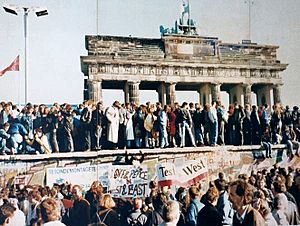
In the 1980s, U.S. President Ronald Reagan challenged the Soviet Union. In 1985, Soviet leader Mikhail Gorbachev introduced reforms, granting freedoms and ending Soviet control over Central and Eastern Europe. The Revolutions of 1989 saw Communist regimes collapse peacefully. The Berlin Wall fell, and East and West Germany unified in 1990. In 1991, the Soviet Union itself dissolved into many republics, most becoming democracies. The West was finally free from Communism.
After the Cold War, Communism largely declined. The United States became the world's only superpower.
Western Countries: 1945–1980
United States: 1945–1980
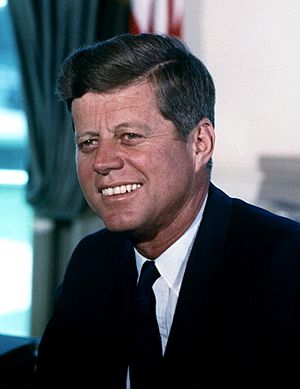
After World War II, the U.S. experienced great prosperity. Many Americans joined the middle class, moved to suburbs, and owned cars and televisions. The "baby boom" led to population growth. More non-wealthy Americans could attend college.
The Civil Rights Movement began, with black Americans seeking full equality. The Brown v. Board of Education Supreme Court decision (1954) outlawed school segregation. Martin Luther King Jr. led non-violent protests. The Civil Rights Act of 1964 and Voting Rights Act banned segregation and discrimination.
The Democratic and Republican parties remained dominant. Federal power expanded, with programs for the elderly and poor. By 1980, many Americans felt less confident due to the Vietnam War and economic problems.
Europe

After the war, much of Europe was in ruins. The continent was split by an "Iron Curtain" between West and East. Western Europe, with U.S. aid (the Marshall Plan) and economic integration through the European Common Market, quickly recovered. West Germany and Italy became leading economies.
In 1957, six Western European nations formed the European Economic Community, which later became the European Union (EU). The EU aimed for economic and political cooperation. Most European countries became welfare states, providing many services like healthcare and pensions through taxation.
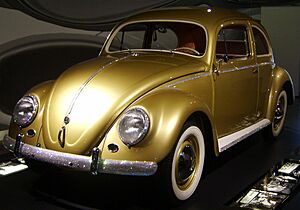
Charles de Gaulle was a key French leader, seeking to restore France's great power status. While Europe was mostly peaceful, Britain faced "The Troubles" in Northern Ireland, and Spain dealt with Basque separatist terrorism.
By 1980, all Western European nations were democracies.
British Empire and Commonwealth 1945–1980
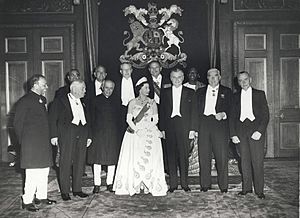
The British Empire transformed into the Commonwealth of Nations, a voluntary association.
Britain
After the war, the Labour Government introduced nationalization and social welfare programs. Britain's global influence declined as decolonization occurred. "The Troubles" in Northern Ireland involved violence between Irish republicans and British loyalists. In 1973, Britain joined the European Common Market. Margaret Thatcher became the first female prime minister in 1979, implementing economic reforms.
Canada
Canada continued to develop its national identity. French and English became official languages. Canada established universal health care.
Australia and New Zealand: 1945–1980
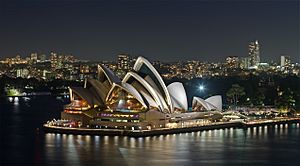
Australia and New Zealand prospered after World War II. They remained constitutional monarchies within the Commonwealth of Nations. After British defeats in the war, they turned to the U.S. for military aid, joining the ANZUS alliance. Both nations established multicultural immigration programs. Relations between European settlers and Indigenous peoples improved through reforms. The arts flourished, with the Sydney Opera House opening in 1973.
Western Culture: 1945–1980


Western culture saw big changes. Mass media created a global culture. Literacy became widespread. Television became common, and a new pop culture emerged with rock and roll.
Religious observance declined. Protestant churches focused more on social issues. The Catholic Church changed some practices in the Second Vatican Council.
The counterculture of the 1960s reacted against conservative norms and the Vietnam War. Institutional racism largely disappeared. Women continued working outside the home, and double-income families became common. Many traditional Western values were questioned.
Rock and roll music emerged from the U.S. with artists like Elvis Presley. British bands like The Beatles and The Rolling Stones gained huge success. Australian bands like The Bee Gees and AC/DC also became famous.
Hollywood became known for film. American cinema influenced the world, with films like To Kill a Mockingbird challenging racial prejudice. The rise of television changed cinema, and directors like Stanley Kubrick and Steven Spielberg explored new themes.
Western Nations: 1980–Present
The 1980s saw economic growth in the West. The 1990s and early 21st century brought prosperity. The World Trade Organization was formed. After Soviet Communism collapsed, Central and Eastern Europe moved towards market economies and democracy. New cooperation emerged with Russia and China, but Islamism became a new challenge, leading to wars in Afghanistan and the Middle East.
The Financial crisis of 2007–2008 affected the West, causing recessions in Europe and the U.S. However, Pacific economies like Australia and Canada largely avoided the downturn due to trade with Asia.

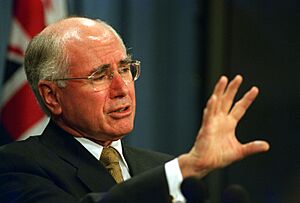
After the Cold War, Russian President Boris Yeltsin pursued closer ties with the West. His successor, Vladimir Putin, tightened political control and had tense relations with Europe and America. Former Soviet countries joined NATO and the European Union.
Democracy and capitalism grew worldwide. Even Communist countries like China and Cuba experimented with market reforms. Free trade agreements like NAFTA (North America) were signed. The West's economy shifted to services and information, with factories moving to China and India.
European countries have good relations. The European Union became more powerful, introducing the Euro currency.
Australia and New Zealand continued multicultural immigration and integrated more with the Asia Pacific region. They maintained ties with Britain but strengthened economic links with Asia.
In 1990, South Africa's white-minority government began dismantling apartheid. In 1994, Nelson Mandela became the first freely elected black president.
The United States became the world's only superpower after 1991. Since 1980, Americans have become more optimistic. Immigration from Asia and Latin America has increased.
On September 11, 2001, the U.S. suffered major terrorist attacks by Islamic extremists. This led to the War on Terrorism and wars in Afghanistan and Iraq. In 2003, the U.S. led a controversial war in Iraq, overthrowing Saddam Hussein.
In 2011, NATO led a military intervention in Libya during its civil war.
Western Society and Culture (Since 1980)
Western culture has become more secular in many regions. However, the Papacy (the Pope's office) remains important. The funeral of Pope John Paul II brought together many world leaders.
Personal computers and the World Wide Web emerged, revolutionizing global communication. The internet allowed free access to information in the West, but some countries used censorship.
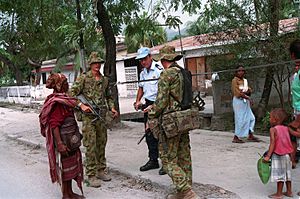
After 1991, Western nations provided aid and troops to war-torn areas. A successful peacekeeping operation was in the Balkans in the late 1990s, after Yugoslavia broke up. Australia led a UN mission in East Timor in 1999.
The Persian Gulf War (1990–1991) saw a UN coalition, including Western nations, liberate Kuwait from Iraq.
The West became less popular in the Middle East due to support for Israel and for some dictatorships. The Islamic Revolution in Iran (1979) established an anti-Western government. The Taliban in Afghanistan offered shelter to Al-Qaeda, which launched attacks on the U.S. The U.S. overthrew the Taliban after the September 11 attacks.
In 2003, the U.S. led a war in Iraq, establishing a democratic government.
Leaders elected in the early 21st century reflect demographic and social shifts: Barack Obama (first African-American U.S. president), Angela Merkel (first female German chancellor), and Julia Gillard (first female Australian prime minister).
See also
- Outline of the history of Western civilization
- Role of Christianity in civilization
- History of Europe
- Eurocentrism




